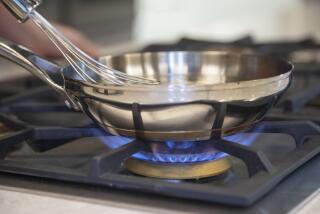Energy Conservation Gains Some Star Power
- Share via
Most people know that standing in front of the refrigerator with the door open runs up the utility bill, but they don’t realize it’s also polluting the environment. The two are linked; even replacing a lightbulb demands a decision that affects the environment.
“The average American home contributes more to air pollution than the average automobile,” said Mark Ginsberg, deputy U.S. assistant secretary of Energy. He was in Los Angeles last week to launch a consumer education campaign with the triple goal of lowering energy consumption, saving money for consumers and reducing pollution.
The Energy Star label, a blue and green globe with a gold star, is the government’s seal of approval. It was created by the Department of Energy and the Environmental Protection Agency, which set the criteria, to help shoppers for large and small home appliances identify the most energy-efficient products on the market.
The campaign is an expansion of a program that originated in 1993 with home computers, said Ginsberg. “It was a fast-growing industry that hadn’t thought about energy use, but they have made great strides in efficiency.”
In addition to spurring savings on utility bills, the new program, which is voluntary for manufacturers and retailers, will be a consciousness-raiser for shoppers who don’t ordinarily make a link between buying an appliance and the environment, says Ginsberg.
“We know the car pollutes because it has an exhaust pipe,” he said. “But home appliances seem so innocent--you just plug them in and turn them on.”
What we don’t see is the power plant activity where coal or oil are being burned to create the electricity the appliances run on, producing, among other pollutants, carbon dioxide, which is the primary cause of global climate change.
“We’ve been very fortunate to have adequate energy supplies in our country and have become very complacent,” Ginsberg said. “We just don’t think of our homes as energy hogs, but they are.”
By federal law, major appliances are already labeled with a yellow and black EnergyGuide, which estimates annual energy consumption (in kWh or kilowatt-hours) and operating cost.
Energy Star products exceed existing federal efficiency standards by, typically, 13% to 15%, said Ginsberg, and for some appliances much more.
“We’re very supportive of the program because it pulls consumers toward the higher efficiency products,” said John Morrill of the American Council for an Energy Efficient Economy in Washington. Morrill, co-author of the council’s 1996 “Consumer Guide to Home Energy Savings,” says there have been dramatic improvements over the last 20 years in all major home appliances. For instance, central air conditioners qualifying for the Energy Star are at least 20% more efficient than those meeting the minimum federal efficiency standards.
“A furnace or an air conditioner is often a panic purchase, so you don’t have time for a lot of comparison shopping,” he said. “A bright, attractive logo could be a big help.”
Energy Star labels are just starting to pop up in appliance and electronics stores; Montgomery Ward (which is reorganizing after filing for bankruptcy protection) and Circuit City stores are the first national retailers to sign on. Eventually, the labels will be extended to housing insulation, lighting fixtures and even new homes.
Shoppers trying to do the right thing will find some categories easier than others. Officials estimate the percentage of products that qualify for Energy Star ratings range from almost 90% in office products such as computers and printers to about 20% in heating and cooling equipment.
The potential is enormous, said Ginsberg. “By the year 2000, we anticipate that American consumers and businesses can save over $2 billion, which is the equivalent of taking 4 million cars off the road.”
Information is available at (888) STAR-YES and on the Internet at https://www.energystar.gov.
More to Read
Inside the business of entertainment
The Wide Shot brings you news, analysis and insights on everything from streaming wars to production — and what it all means for the future.
You may occasionally receive promotional content from the Los Angeles Times.










